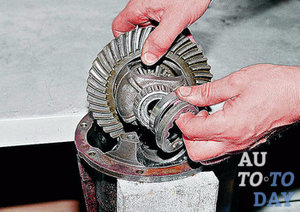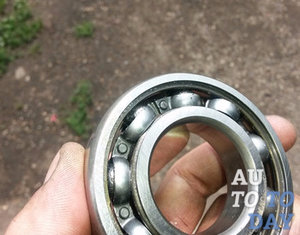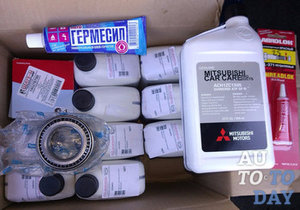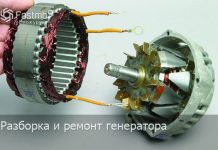In detail: do-it-yourself automatic transmission differential repair from a real master for the site my.housecope.com.
The differential is an important structural element of the transmission. It transfers, changes, redistributes torque between two consumers. If necessary, provides their rotation with different angular velocities.
Simply put, this mechanism lowers the rpm from the gearbox to the drive wheels, and also allows the drive wheels of the car to rotate at different speeds. For clarity, how this mechanism works, watch the informative video:
The design is based on a planetary gearbox. The gearbox has a worm gear, spur gear and bevel gear. In a VAZ 2110 car, a bevel differential works and it has the following device:
- frame;
- satellites;
- half-axle gears.
The location of this unit depends on what kind of drive the driving wheels are. In a VAZ 2110 car, as in all front-wheel drive cars, the differential is located in the gearbox.
The reasons for the breakdown of this important unit can be wear or damage to bearings, oil seals, differential crosspiece. Damage can be due to insufficient oil level. As a result, the noise level in the axle or gearbox (gearbox) rises markedly.
The price of a disc differential lock for a VAZ 2108-2110 car from ValRacing is 11,000 rubles. And the cost of a screw limited slip differential for Daewoo, Opel or Chevrolet "ValRacing" with preload is about 15,500 rubles.
What can you do on your own to fix the breakdown of this part? A few consecutive recommendations will help you deal with the problem.
| Video (click to play). |
Since it was already said that the differential is in the gearbox, therefore, this unit must be removed from it for repair. To do this, read the article, which deals with how to remove the differential (step # 30).
Now we proceed to the analysis of the design itself:
1. Take out the side gears by rotating them around the axis of the satellites by 90 degrees.
2. Before removing the satellites, you need to remove the retaining ring from their axis.
3. Now you can easily remove the axle and two satellites.
4. To free the driven gear, you need to unscrew the mounting bolts in the differential housing.
5. Disconnect the part from the body using a hammer and chisel.
6. Everything that was disconnected: satellites, their axle, gear - carefully inspect for a defect. If the surfaces of these parts, and the surface of the body itself, have irregularities or polyps, carefully remove them with fine-grained sandpaper.
Be prepared for the fact that some defects cannot be eliminated, which means you will have to buy a new part.
7. Pay special attention to the driven gear in the checkpoint. It is possible that defects in this part interfere with the normal operation of the differential. If you find significant tooth wear, chipping or mowing, the gear will need to be replaced.
Advice: The drive and driven gears are sold together (as a pair). Therefore, it is better to replace both at once. On the driven, the manufacturer must indicate the number of teeth, both of the first and second gears. However, “trust but verify” - the proverb says, and to check the number of teeth it is better to count and compare.
8. Check the suitability of the bearings. Pitting and indentation marks on the treadmills and rolling elements indicate their damage. Verdict: requires replacement.
The differential housing itself will have to be replaced if the bearing seats are significantly worn out.
1. Without worrying too much about their integrity, press this damaged part.
2.If there is a special puller, then remove the outer rings from the gearbox and clutch housings.
In the event that there is no special device, first remove the seals of the axle shafts. Then remove the bearing rings from the outside of the crankcase. But, be prepared: in this case, the oil seals deteriorate and must be replaced.
3. If there is an adjusting ring under the gearbox crankcase ring, then before placing new rings in the crankcase, you need to select the adjusting ring again.
4. A damaged speedometer drive gear can be replaced in such a way that the bearing remains intact. To do this, take two screwdrivers and press on the inner bearing ring, pressing the part itself. This will destroy the drive gear, but it doesn't matter - it must be replaced.
5. This is how the VAZ 2110 differential is disassembled, broken parts are changed and minor defects are corrected. Now you can assemble this mechanism in the reverse order of disassembly. In the process, do not forget to process the parts with transmission oil, and fasten the driven gear with the marking of the teeth outward (see photo above).
- Replacing the automatic transmission differential bearing
- 1. When do I need to replace the automatic transmission differential bearing?
- 2. The process of replacing the automatic transmission differential bearing
- 3. What is needed to replace the automatic transmission differential bearing
A differential is a special mechanical device designed to transfer rotation from one source to two others. In this case, the angular speeds of rotation of the source and consumers must be independent. In other words, this mechanism is able to reduce the speed from the gearbox to the drive wheels, and also allows the latter to rotate at different speeds. Currently, there can be a wide variety of signs of automatic transmission problems, which, in turn, gives car owners all the necessary information about the nature of the breakdown. So, for example, faults in the valve body are accompanied by the appearance of significant jolts when shifting gears. Moreover, such shocks are characterized by an increase in intensity and are hardly noticeable at the initial stages, but over time they progress and become more noticeable.
The main manifestations of automatic transmission malfunctions are a complete refusal to switch the operating modes of the box or blocking of its operation in a specific gear. In such a situation, the vehicle owner will have to use the services of a tow truck. It is highly undesirable to drive a car with a broken gearbox, as this can lead to very serious damage to the drive and the entire automatic transmission.
Failure of the automatic transmission differential bearing and gear wear is often accompanied by the already mentioned growing hum, vibration during movement and other extraneous sounds of unknown origin. Depending on the number of revolutions of the engine, the noise increases and can be supplemented by the appearance of a metallic grinding.
If you decide to replace a damaged or worn out bearing at home, then you need to be aware of the features of this process. The essence of the problem is to press the differential box from the axle. Of course, the removed part is no longer suitable for installation, as the separator is seriously damaged. When carrying out diagnostics, you should carefully examine the working surfaces and teeth of the satellites, splines and teeth of the side gears. If these parts show signs of wear and damage, then they will also need to be replaced.
So, first you need to disconnect the selector cable, oil hoses and several electrical connectors from the automatic transmission. Then raise the front of the vehicle and remove the drive shafts. The motor itself is suspended on a traverse, after which the longitudinal ski, box cushions, as well as fasteners for connecting to the car engine are unscrewed.
Then the box is removed and, in a more convenient position, they diagnose and replace all damaged parts: they sort out the oil seals, change the oil filter, take out the differential and replace its bearings. Also, it will be useful to clean the bell mating surface from the old sealant, followed by applying a new composition. At the end of the procedure, after the sealant is completely dry, all parts are reassembled in the reverse order.
To perform certain repair tasks, the presence of special tools is a prerequisite, especially if the question concerns such a complex mechanism as an automatic transmission. As we already said, before replacing the automatic transmission differential bearing, you will have to dismantle the box itself. Some car owners quite successfully carry out this process using a hand winch, and wooden linings are installed under the power unit pallet.
Naturally, each individual vehicle model may require other tools, but kits for performing automatic transmission repairs, as a rule, already include everything you need, you just need to find out the size and type of fasteners or removable / installed parts. Many car owners often make do with improvised means, which, by the way, is an extremely rash act, since a hammer or a crowbar can cause serious damage to parts, and only a complete replacement of the element will help get rid of them.
Differential is usually called a complex mechanical device that provides different speeds at the same time rotating drive wheels.
Differential faults are usually identified by transmission diagnostics. However, drivers may themselves notice a change in the sound that usually comes from the gearbox. After such a complaint, experienced mechanics immediately offer the owner automatic transmission differential repair his car.
Prices for automatic transmission differential repair
If you have questions or need advice, call!
Both the repair of the automatic transmission differential and the replacement begin with its dismantling. Then the assembly is disassembled and a sequential assessment of the health of all its elements is carried out.
Among the faults most frequently encountered after diagnostics, one can single out:
- worn out gear teeth on the speedometer drive;
- damage to the bearing;
- surface defects of splines, satellites, teeth and gear washers.
If the degree of wear is too high, it is better to replace the elements.
This also applies to the entire differential housing. If the defects are insignificant, they are usually removed with "sandpaper".
If automatic transmission differential repair is completed, its installation is being carried out, while a number of such points must be taken into account: the bolts must be tightened diagonally and evenly, and the drive gear is heated in boiling oil. These rules are known to car service specialists, who should certainly be entrusted with the repair or replacement of the automatic transmission differential.
The procedure for repairing your car in "Automatic Transmission Service"
Step 1. Call us and we will find a convenient time to repair your car. If your car is not on the move, we can deliver it to our car service using a tow truck, and there is also a guarded parking on our territory.
Step 2. Before starting work on the diagnosis and repair of the automatic transmission, we wash the car at the car wash and tighten the seats with covers so as not to contaminate the interior during repairs.
Step 3. Our specialists carry out diagnostic work, during which the causes of the malfunction are identified and the cost of the work is formed.
Step 4. A repair plan and a list of spare parts required for repair are drawn up.
Step 5. A preliminary estimate of the cost of the repair is made. After agreeing on the estimate with the client, repair work begins.
Step 6. Repairs are carried out in full accordance with the manufacturer's requirements.
Step 7. After the repair, the car is run-in to check the quality of the work performed.
Step 8. The foreman hands over the repaired car to the client, the operability is checked after the repair.
Step 9. Signing of documents, including an act of completion and a warranty card.
Step 10. The job is done, and you leave our service in a repaired car.
In my garage in the pit, I pulled the drives that come out of the automatic transmission, hang out very much. drove into the "garage service", I thought the internal grenade or generally say to change the drives. And they say - the diff is broken, the automatic transmission needs to be repaired, the drives are in order. I am inclined to believe them, because they do not do such repairs)
The box is not in the best condition, a jerk when switching on 2 gears, plus it gets under way for a long time (two seconds), and also the slurry does not change at least 25 thousand (how much I own), it stinks of burning, but light.
So this is the point, fix or contract? And what are the prices now (the original repair kit costs 12 thousand at the existential level)? Is it really possible to sort out the same as moving? Or maybe you can still drive another 25 thousand?, Because I already have a repair of engines due to oil, I'm afraid I won't pull 2 repairs.
well, it began with the fact that it bryakaet in front and it is not clear what, the silentlets are almost intact, the racks say you can pump up (.) but in general they are alive. So I tried to find the source myself
Excursions, tours
Transfer of tourists across the Baikal region
Inexpensive
In what plane do they hang out? Are there no extraneous sounds during trading, acceleration (like ringing, crunching or vibrations)?
Whole anthers on the racks? Check the stabilizer struts and bushings.
If the automatic transmission does not slip, then it's okay, start by replacing the slurry and checking for shavings.
On my Honda CR-V, after a complete shake-up of the suspension, something blurred, it’s unpleasant. It turned out - the pads were strumming in the caliper). Bryakaet, bryakat, pressed the brake - stopped).
An automatic transmission is an expensive component. There is no point in delaying the repair if it starts to work incorrectly. In a car service, such repairs are expensive. You have to pay for the work of specialists and for the details.Having studied the market and the price range of services in this segment, motorists come to the conclusion that repairing automatic transmissions with their own hands is not such a pointless undertaking. The prices of the workshop masters cannot be called modest, and the professionalism does not always correspond to the price. And, after some thought, motorists can decide to fix the problem on their own.
Wherever you decide to repair the gearbox, the whole process goes according to the following scheme:
- diagnostics,
- dismantling the box,
- disassembly of the box,
- complete set with spare parts,
- assembly (installation),
- installation on a car,
- diagnostics after repair.
To fix the problem yourself, you will need some car mechanic skills, tools, a certain amount of time to work with, patience and perseverance.
All automatic transmissions are arranged the same, but there are two types of transmission control - hydraulic and electronic. Their renovation has some differences.
It is important to notice transmission problems at the earliest possible stage. Then, with the correct diagnosis, complex repairs can be avoided. Quiet and smooth operation of the automatic transmission is considered normal. There are a lot of signs that something is wrong with the box. Most often these are extraneous sounds when changing gears or during robotic transmission. It can be crunching, clicks. An unpleasant smell also speaks of problems. It can appear during long-term or short-term operation of the box. It is worse if the gear shifting slows down, or one of them does not work at all. Then immediate intervention is required.
Do not be lazy to look under the car, it should be clean there. Red spots will indicate an oil leak from the transmission. Checking the oil level regularly is a must. Normally, it should be translucent, reddish in color. No burning smells or muddy shades! If they appear, it's time to change the oil.
Automatic transmission malfunctions often arise due to improper operation. The transmission becomes unusable due to insufficient oil level or overheating. For this reason, the gears wear out, the machine can jerk when changing gears. As a result, any part of the automatic transmission may fail. Shocks when driving indicate overheating of the oil and the appearance of problems in the valve body.
Aggressive driving with hard acceleration and braking will erase details. Does not add durability to the box and driving in traffic jams, slipping. All this leads to overheating of the box and has a bad effect on its general condition.
All faults are divided into two subgroups. They can occur in
- electronic control system,
- mechanical and hydraulic parts of the gearbox.
If a malfunction occurs, the automatic transmission goes into emergency mode, that is, it goes into third speed and does not switch. The corresponding icon appears on the display.
If problems have arisen with the electronics, then it will not be possible to fix them by repairing the automatic transmission. Therefore, it is important to understand the nature of the faults.
In diagnostics, the main thing is to collect the necessary information and interpret it correctly. Therefore, it is better to consult a specialist. Determine what the problem is at the service station, and take care of the repair yourself. Without proper experience and equipment, you will spend a lot of time on diagnostics. There are mechanical and computer diagnostics.
General scheme of diagnostic procedures:
- check the oil,
- check the operation of the engine at idle speed, the connection points of the wiring and cables,
- determine the error codes of the operation of the control units (CU) of the gearbox and engine,
- check the box on a car without movement,
- check the automatic transmission in motion,
- check the pressure inside the control system.
If the cause of the malfunctions is electronics problems, then most likely you will not need to dismantle and disassemble the automatic transmission. Diagnostics of malfunctions in this system is carried out by the control unit.It monitors the sensor signals, the transmission ratio and the resistance of the output circuits. Malfunctions of such parts and assemblies may occur:
- input sensors,
- electronic control unit,
- executive devices of the control system,
- violation of the integrity of the electrical wiring connections.
The transmission computer receives signals from various sensors. If some parameters are out of order, it writes the code of this problem (DTC) into memory. You can decrypt such numbers using a special scanner.
These are the main problems of the automatic transmission itself. They are conventionally divided into three subgroups:
- Damage to friction groups, bushings and housings, calipers, planetary gear sets, pump and other mechanics.
- Defective transformer. This includes:
- breaks in the splines of the wires,
- mechanical destruction of the blades,
- overrunning clutch,
- wear of the main blocking clutch,
- depressurization of the piston oil seal.
- Problems with the mechanics of the hydraulic plate.
If the diagnostics were successful and you cannot do without dismantling, then we proceed to this stage of the automatic transmission repair.
You will need a special lift, or at least a viewing hole. As well as a transmission jack and a set of keys. It is better to perform this procedure in a specially equipped garage or box. It will not be superfluous to invite several physically strong guys to help you move the removed box. Its weight is beyond the strength of even a very strong person. Further action plan:
- disconnect all communication tubes and cables;
- unscrew the torque converter mounting bolts, as well as the motor flywheel membranes;
- remove and move the gearbox;
- assess the scale of the breakdown and start repairing.


Before removing the gearbox, the oil does not need to be drained from it. However, then do not forget to substitute the container at the place where the oil supply pipes are attached when you disconnect them - otherwise you will get an ugly puddle under your feet.
All actions must be careful. Sudden movements can damage the splines on the input shaft of the diaphragm.
It is better to do automatic transmission repair with your own hands, having it at hand proprietary manual and a printed diagram of the gearbox. First you need to inspect all the systems that serve the gearbox, mounts and blocks. Then we proceed to the repair. For this:
- We disassemble the gearbox, wash and dry the parts and check them for defects.
- We change all gaskets, seals, as well as worn out parts.
- Remove the inhibitor block and sump. We clean out the dirt inside. It looks like metal magnetic shavings.
- We remove the wiring of the ring from the plug and push them inside the plug.
- Remove the valve body, loosen the brake band bolts. We wash the valve body.
- We check the clutches, gears and planetary gears for wear. We will replace it if there is such a need. All internal rubber bands must be changed!
- We open the oil pump. We check all the details, especially the filter. We change what has already served its term. We use the manual so as not to swap parts.
- We take out the valves and springs. We wash the valves. Their sticking can be the reason for incorrect operation of the automatic transmission. Replace the accumulator springs if they are broken.
- Putting everything back into place. It is important not to confuse anything!
- We replace rings and friction bolts.
- We check the gear shift assembly and the large piston and put the oil pump in place.
Assembly takes place upside-down.
There are some points that it is advisable to take into account when repairing. Often a transmission problem is related to the filter. It will not be possible to change it without removing the valve body. And when it is removed, the gasket breaks. To replace it, you will need to disassemble the valve body completely. The same applies to the accumulator spring from first to second gear. A special stopper does not allow you to remove it without disassembling the valve body. All valve body gaskets are very similar, do not mix them up. Assembling the valve body, we tighten it with a torque wrench. It is important not to overtighten here.
If all the breakdowns are eliminated, we install the automatic transmission.The moment is responsible, haste is inappropriate here. During these works, the following recommendations should be adhered to:
- When installing the automatic transmission in its place, the diaphragm is checked for end runout using an indicator head. If such a defect occurs, then it must be replaced.
- The radiator is flushed until the gasoline is clean. Then a liter of transmission oil is poured into the gas turbine engine and put on the input shaft. You need to achieve a secure connection and a complete fit. Then you need to dock the engine with the box along the guide centering pins. The crankcases must abut completely.
- Tightening the bolts in the box is the next step. After that, the absence of gaps along the entire plane is checked. After connecting all the highways, the correctness of the connections is checked.
- At the final stage, oil is poured and the operation of the automatic transmission is checked at low engine speeds.
Beginning the installation of the box, be sure to check for the presence of centering pins on the crankcase flange - there should be two of them. If at least one is missing, the automatic transmission cannot be attached.
Automatic transmission repair and diagnostics do it yourself - not an easy, but feasible task. Choosing a car with an automatic transmission, novice car enthusiasts believe that repairing it at home is impossible. This is not true. But before deciding to carry out such important work at home, you need to weigh all your possibilities. Then you will not be in for unpleasant surprises during the renovation.














